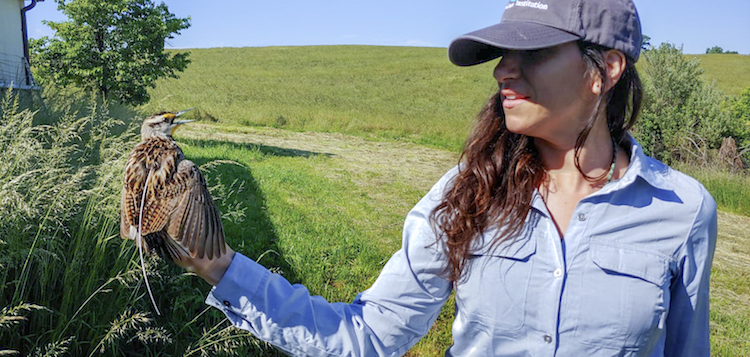As a researcher at the Smithsonian Migratory Bird Center and Georgetown University in Washington D.C., Amy Scarpignato (‘11, M.S. Wildlife) is part conservationist and part investigator. Working with scientists and organizations across the world, she helps to map where and why bird populations are declining, and in some cases, recovering.
“We start by asking, ‘Where are the birds and where do they go?’ It’s our job to find out,” explains Scarpignato. “Tracking is an important part of solving the puzzle.” For the past 10 years, her job has been to investigate why bird populations are declining before it's too late.
After graduating from Cal Poly San Luis Obisbo in 2003, Scarpignato traveled around the country as an itinerant field biologist, working on nearly 15 different research projects with many different species of songbirds, raptors, waterfowl, and shorebirds. She enjoyed the years of rough and tumble seasonal work, but asked herself, what’s next?
Drawn by the longstanding reputation of HSU’s Wildlife program, Scarpignanto arrived in Arcata in 2009, ready to advance her tracking and trade skills in graduate school. With seven years of field experience already under her belt, Scarpignato quickly became a resource for the Wildlife department, teaching undergraduates how to band birds and specifically, the technique of radio telemetry.
“My thesis project used radio telemetry to analyze the home range of common ravens in Redwood National Park, which included tracking their nesting locations, foraging patterns, and habitat,” explains Scarpignato. Using the tracking data and GIS mapping tools, Scarpignato’s research sought to determine whether ravens were responsible for the predation of endangered marbled murrelet nests.
In order to track the ravens, Scarpignato first had to affix each bird with a backpack tracking device. It was no easy task. Incredibly intelligent animals, the ravens often recognized Scarpignato before she got out of her car in Redwood National Park. With ravens dive bombing her Corolla, she learned to work quickly.
“I would practice by putting the backpack-mounted radio transmitters on study skins from HSU’s taxidermy collection,” remembers Scarpignato. “My professors and visiting professionals from Wildlife department seminars demonstrated essential field techniques and helped sharpen my GIS skills.”
Today at the Smithsonian, Scarpignato regularly faces challenges like how to deploy a new tracking technology on various species. One of her primary projects is the Atlas of Migratory Connectivity, which includes mapping, banding and tracking data on North American migratory birds. The Audubon Society recently recognized Scarpignato for the Smithsonian and Georgetown University’s massive undertaking to investigate declining bird populations.
“After all these years, I still get to spend time in the field tracking birds and testing new tracking technologies ,” says Scarpignato. “It’s been a dream job.”
For more information, visit nationalzoo.si.edu/migratory-birds.
Photo: Amy Scarpignato holds an Eastern Meadowlark with a transmitter in Front Royal, Virginia. (Photo by Amy Johnson)

